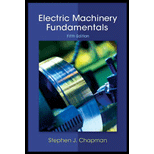
Electric machinery fundamentals
5th Edition
ISBN: 9780073529547
Author: Chapman, Stephen J.
Publisher: MCGRAW-HILL HIGHER EDUCATION
expand_more
expand_more
format_list_bulleted
Concept explainers
Textbook Question
Chapter 1, Problem 1.4P
A motor is supplying
Expert Solution & Answer
Trending nowThis is a popular solution!

Students have asked these similar questions
6. Answer the following questions. Take help from ChatGPT to answer these questions
(if you need). Write the answers briefly using your own words with no more than two
sentences, and make sure you check whether ChatGPT is giving you the appropriate
answers in our context.
A) What is a model in our context?
B) What is an LTI system?
C) What are the three forms of model we have used in the class so far to represent
an LTI system? Among the above three forms, which forms can still be used to
represent a nonlinear system?
5. Consider the following block diagram of a system in the Figure 4.
Y₁(s)
G₁
G2.
R(s)
C(s)
Y₂(s)
G3
G4
Figure 4
The models of the blocks G1, G2, G3 and G4 are represented by a differential
equation, transfer function, state-space form, and impulse response as the
followings.
dy1
G₁:
+2y₁ = 3r(t)
dt
1
G2: G₂(s) =
S+3
G3: x=2x+r,
y2=3x-r
G4: h(t)=8(t) + et 1(t)
Find the simplified expression of the overall transfer function of the system i.e., G(s) =
Note for G3 block, you may need to use the formula H(s) = C (sI - A)-¹ B+ D.
C(s)
R(s)
4. Simplify the block diagram in Figure 3 and find the closed-loop transfer function
G(s) =
C(s)
R(s)
G₁
R(s)
Figure 3
C(s)
G2
H₁
H₂
Chapter 1 Solutions
Electric machinery fundamentals
Ch. 1 - What is torque? What role does torque play in the...Ch. 1 - What is Amperes law?Ch. 1 - What is magnetizing intensity? What is magnetic...Ch. 1 - How does the magnetic circuit concept aid in the...Ch. 1 - What is reluctance?Ch. 1 - What is a ferromagnetic material? Why is the...Ch. 1 - How does the relative permeability of a...Ch. 1 - Prob. 1.8QCh. 1 - What are eddy current losses? What can be done to...Ch. 1 - Why are all cores exposed to ac flux variations...
Ch. 1 - What is Faraday law?Ch. 1 - What conditions are necessary for a magnetic field...Ch. 1 - What conditions are necessary for a magnetic field...Ch. 1 - Prob. 1.14QCh. 1 - The linear machine in Figure 1-19 is running at...Ch. 1 - Just how does a decrease in flux produce an...Ch. 1 - Will current be leading or lagging voltage in an...Ch. 1 - What are real, reactive, and apparent power? What...Ch. 1 - What is power factor?Ch. 1 - Prob. 1.1PCh. 1 - A flywheel with a moment of inertia of 4kgm2 is...Ch. 1 - A force of 10 N is applied to a cylinder of radius...Ch. 1 - A motor is supplying 50Nm of torque to its load....Ch. 1 - A ferromagnetic core is shown in Figure P1-2. The...Ch. 1 - A ferromagnetic core with a relative permeability...Ch. 1 - A two-legged core is shown in Figure P1-4. The...Ch. 1 - A core with three legs is shown in Figure P1-5....Ch. 1 - A two-legged core is shown in Figure P1-4. The...Ch. 1 - A wire is shown in Figure P1-7 that is moving in...Ch. 1 - Repeat Problem 1-10 for the wire in Figure P1-8.Ch. 1 - Prob. 1.12PCh. 1 - A core with three legs is shown in Figure P1-10....Ch. 1 - A two-legged magnetic core with an air gap is...Ch. 1 - A transformer core with an effective mean path...Ch. 1 - The core shown in Figure P1-2 has the flux shown...Ch. 1 - Prob. 1.17PCh. 1 - Prob. 1.18PCh. 1 - Prob. 1.19PCh. 1 - Demonstrate that Equation (1-59) can be derived...Ch. 1 - Prob. 1.21PCh. 1 - Prob. 1.22PCh. 1 - For the linear machine of Problem 1-22: When this...
Knowledge Booster
Learn more about
Need a deep-dive on the concept behind this application? Look no further. Learn more about this topic, electrical-engineering and related others by exploring similar questions and additional content below.Similar questions
- 1. Consider a system defined by the following state-space equations. -5 2 N-MAN-G = 3 -1 y = [12] Find the transfer function H(s) = x1 x2. Y(s) U(s)' + 5arrow_forward3. Simplify the block diagram in Figure 2 and find the closed-loop transfer function G(s) = C(s) R(s)' G₁ C(s) R(s) G2 G3 G4 Figure 2arrow_forwardRigid network supplies Feeder 1 through 110/21 kV transformer (Figure 1). Short circuit power of the supplying network is 5000 MVA and voltage is 110 kV. Determine 3-phase short circuit current for the point A. Draw 1-phase equivalent diagram. How big is the current if the 3-phase short circuit occurs in the Busbar? 110/21 kV Busbar Supplying network S = 16MVA 4-10% Figure 1. Feeder 1: 1-5km - r = 0.337 2/km x 0.361 2/km Aarrow_forward
- Rigid network supplies Feeder 1 through 110/21 kV transformer (Figure 1). Short circuit power of the supplying network is 3000 MVA and voltage is 110 kV. Length of feeder 1 is 5 km. Determine 3-phase short circuit current for the point A. Draw 1-phase equivalent diagram. 110/21 kV Busbar Supplying network S = 16MVA 4-10% Feeder 1: Figure 1. - 1 = 5km r = 0.337 2/km x = 0.361 2/km Aarrow_forwardhelp me to solve this question in detail. thank youarrow_forwardI need help with this problem and an explanation of the solution for the image described below. (Introduction to Signals and Systems)arrow_forward
arrow_back_ios
SEE MORE QUESTIONS
arrow_forward_ios
Recommended textbooks for you
 Electricity for Refrigeration, Heating, and Air C...Mechanical EngineeringISBN:9781337399128Author:Russell E. SmithPublisher:Cengage Learning
Electricity for Refrigeration, Heating, and Air C...Mechanical EngineeringISBN:9781337399128Author:Russell E. SmithPublisher:Cengage Learning

Electricity for Refrigeration, Heating, and Air C...
Mechanical Engineering
ISBN:9781337399128
Author:Russell E. Smith
Publisher:Cengage Learning
Power vs Torque - In Depth Explanation and Mythbusting; Author: kyle.Engineers;https://www.youtube.com/watch?v=X7KWtf4wqN4;License: Standard Youtube License